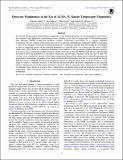Files in this item
Quiescent prominences in the era of ALMA. II. Kinetic temperature diagnostics
Item metadata
| dc.contributor.author | Gunár, Stanislav | |
| dc.contributor.author | Heinzel, Petr | |
| dc.contributor.author | Anzer, Ulrich | |
| dc.contributor.author | Mackay, Duncan Hendry | |
| dc.date.accessioned | 2018-01-22T12:30:05Z | |
| dc.date.available | 2018-01-22T12:30:05Z | |
| dc.date.issued | 2018-01-20 | |
| dc.identifier | 251697190 | |
| dc.identifier | d9f64642-22fb-4cad-b6a6-42385ea798a4 | |
| dc.identifier | 85041109854 | |
| dc.identifier | 000423090600007 | |
| dc.identifier.citation | Gunár , S , Heinzel , P , Anzer , U & Mackay , D H 2018 , ' Quiescent prominences in the era of ALMA. II. Kinetic temperature diagnostics ' , Astrophysical Journal , vol. 853 , no. 1 , 21 . https://doi.org/10.3847/1538-4357/aaa001 | en |
| dc.identifier.issn | 0004-637X | |
| dc.identifier.other | ORCID: /0000-0001-6065-8531/work/58055459 | |
| dc.identifier.uri | https://hdl.handle.net/10023/12557 | |
| dc.description | Funding: UK STFC, the Leverhulme Trust, and NASA (D.H.M.) | en |
| dc.description.abstract | We provide the theoretical background for diagnostics of the thermal properties of solar prominences observed by the Atacama Large Millimeter/submillimeter Array (ALMA). To do this, we employ the 3D Whole-Prominence Fine Structure (WPFS) model that produces synthetic ALMA-like observations of a complex simulated prominence. We use synthetic observations derived at two different submillimeter/millimeter (SMM) wavelengths—one at a wavelength at which the simulated prominence is completely optically thin and another at a wavelength at which a significant portion of the simulated prominence is optically thick—as if these were the actual ALMA observations. This allows us to develop a technique for an analysis of the prominence plasma thermal properties from such a pair of simultaneous high-resolution ALMA observations. The 3D WPFS model also provides detailed information about the distribution of the kinetic temperature and the optical thickness along any line of sight. We can thus assess whether the measure of the kinetic temperature derived from observations accurately represents the actual kinetic temperature properties of the observed plasma. We demonstrate here that in a given pixel the optical thickness at the wavelength at which the prominence plasma is optically thick needs to be above unity or even larger to achieve a sufficient accuracy of the derived information about the kinetic temperature of the analyzed plasma. Information about the optical thickness cannot be directly discerned from observations at the SMM wavelengths alone. However, we show that a criterion that can identify those pixels in which the derived kinetic temperature values correspond well to the actual thermal properties in which the observed prominence can be established. | |
| dc.format.extent | 11 | |
| dc.format.extent | 2264917 | |
| dc.language.iso | eng | |
| dc.relation.ispartof | Astrophysical Journal | en |
| dc.subject | Sun: filaments, prominences | en |
| dc.subject | Sun: radio radiation | en |
| dc.subject | Radiative transfer | en |
| dc.subject | Methods: numerical | en |
| dc.subject | QB Astronomy | en |
| dc.subject | QC Physics | en |
| dc.subject | NDAS | en |
| dc.subject.lcc | QB | en |
| dc.subject.lcc | QC | en |
| dc.title | Quiescent prominences in the era of ALMA. II. Kinetic temperature diagnostics | en |
| dc.type | Journal article | en |
| dc.contributor.sponsor | Science & Technology Facilities Council | en |
| dc.contributor.sponsor | Science & Technology Facilities Council | en |
| dc.contributor.sponsor | The Royal Society of Edinburgh | en |
| dc.contributor.institution | University of St Andrews. Applied Mathematics | en |
| dc.identifier.doi | 10.3847/1538-4357/aaa001 | |
| dc.description.status | Peer reviewed | en |
| dc.date.embargoedUntil | 2018-01-18 | |
| dc.identifier.grantnumber | ST/N000609/1 | en |
| dc.identifier.grantnumber | ST/K000950/1 | en |
| dc.identifier.grantnumber | N/A | en |
This item appears in the following Collection(s)
Items in the St Andrews Research Repository are protected by copyright, with all rights reserved, unless otherwise indicated.

